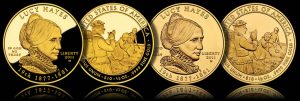
Collectors should watch for the United States Mint to slash prices on 14 numismatic gold coin products mid-Wednesday, based on the bureau’s pricing policy and the recent southerly direction of precious metals.
Highlighting gold’s extreme volatility of late, if the cuts happen as expected, they would mark a fifth straight week that the United States Mint adjusted its gold coin prices and a fourth consecutive week that they have become cheaper.
[Update: The Mint cut coin prices to the expected levels at approximately 12:00 p.m. ET on Wednesday. Due to lower platinum costs, the United States Mint also reduced the American Eagle Platinum Proof Coin by $100 from $1,892.00 to $1,792.00. Most affected products had their ordering option frozen for about 30 minutes during the price adjustments.]
The Mint’s coin pricing methodology uses an average for gold based on AM and PM London fixings from the previous Thursday to current Wednesday. Unless Wednesday’s PM fixing jumps to $1,650.00 an ounce or above — $23+ from where spot prices are as of this writing, the following new gold coin prices should be expected:
Current Gold Coin Prices and Expected Price Cuts
| US Mint Product | Current Price | Expected Price | Price Cut |
| Uncirculated First Spouse Coins | $991.00 | $966.00 | $25.00 |
| Proof First Spouse Coins | $1,004.00 | $979.00 | $25.00 |
| American Gold Buffalo | $1,960.00 | $1,910.00 | $50.00 |
| 1 oz Uncirculated Gold Eagle | $1,928.00 | $1,878.00 | $50.00 |
| 1 oz Proof Gold Eagle | $1,935.00 | $1,885.00 | $50.00 |
| 1/2 oz Proof Gold Eagle | $981.00 | $956.00 | $25.00 |
| 1/4 oz Proof Gold Eagle | $503.50 | $490.50 | $12.50 |
| 1/10 oz Proof Gold Eagle | $215.50 | $210.50 | $5.00 |
| Proof Gold Eagle 4-Coin Set | $3,585.50 | $3,493.00 | $92.50 |
Expected price cuts listed for the 24-karat First Spouse coins include those honoring Lucy Hayes, Julia Grant and Eliza Johnson as well as the proof honoring Mary Todd Lincoln. The Lincoln uncirculated version is no longer available.
The prices above are based on an average of gold falling between $1,600.00 to $1,649.99 an ounce. Last Wednesday prices were reduced for collector gold coins when the precious metal dipped between 1,650.00 to $1,699.99 an ounce. During the adjustments, the Mint froze online ordering for the effected products for about an hour until their return at just after 1 p.m. ET.
The Mint last raised prices on its gold coin products on September 7 after several days of suspensions when gold shot above $1,880 an ounce, or more than $250 higher than where the metal stands now. As an example of an increase, the popular one-ounce Proof American Gold Eagle was raised to $2,135.00, which is $250 higher than where the coin is expected to be priced at on Wednesday.
United States Mint investment-grade coins, like the bullion versions of the American Eagle and American Buffalo, do not have fixed weekly prices like proof and uncirculated collector gold coins. They are instead sold for a small amount over the current price of the precious metal they contain.
For more information on any of the above products, visit the Mint’s website at http://www.usmint.gov/catalog or this site’s U.S. coinage page.





